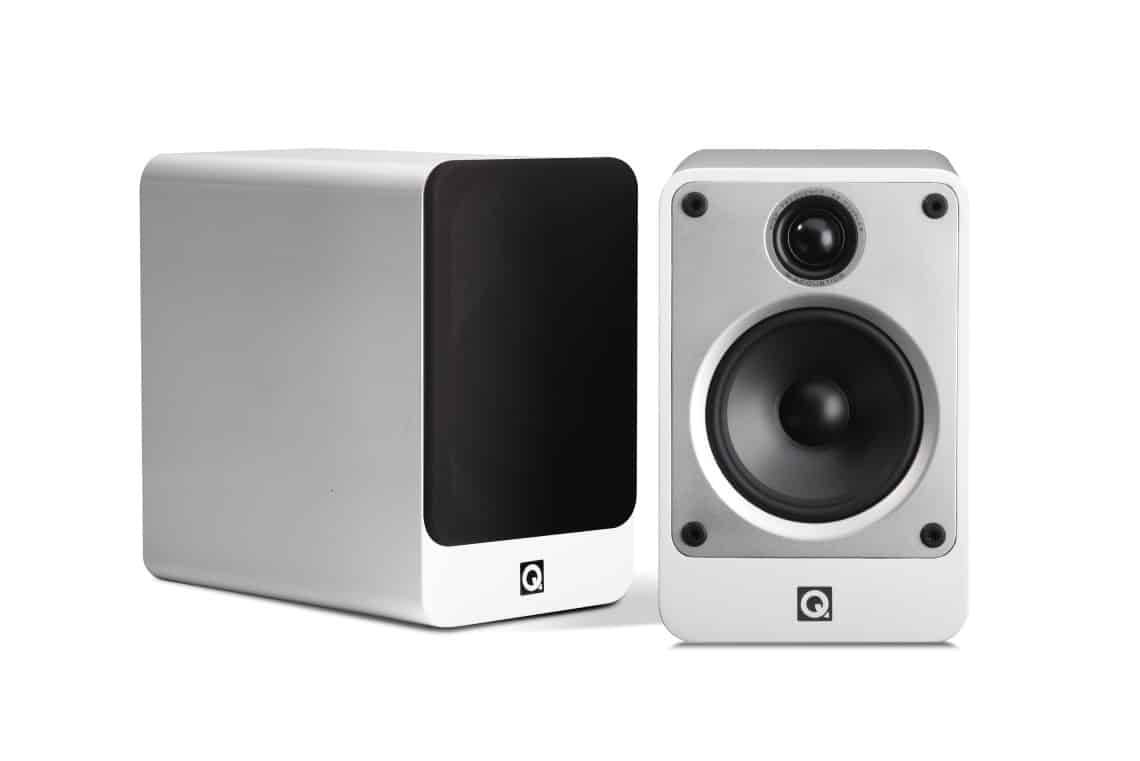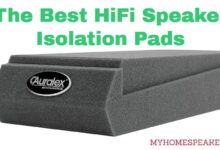In this article, I’m going to present an extensive guide on How to make hifi speakers (custom) by yourself.
Our experts strongly insist that it is cheaper to build custom HiFi speakers than buying already assembled ones in the market.
It may take you more than 48 hours to construct your custom HiFi speaker if you’ve got all the necessary components.
Nevertheless, sometimes, it may take a very long time before you can achieve your dream speaker.
Table of Contents
Why should you make a HiFi speaker by yourself?
Although there are cheap HiFi speakers out there in the market, they are really packed with such drivers that can produce an audiophile-level sound.
When you make your speakers by yourself, you will get the exact drivers and components that you need. This leaves you with the possibility of creating the best HiFi speaker for your needs.

Quite a lot of people don’t really understand what a HiFi speaker really is; they just go to a shop and look for the speaker(s) with HiFi label.
Some other ones believe that speakers with high wattage are HiFi speakers; well, that’s obviously a misconception.
HiFi stands for hi-fidelity; it is a term used to refer to high-fidelity (high-quality) sound reproduction.
A speaker is said to a HiFi speaker with it reproduces clean hi-fidelity sound, according to audiophiles.
Many of the speakers we use every day are not HiFi, but that doesn’t mean they aren’t good speakers. There are impressive speaker systems out there that are not HiFi-rated.
Also, one of the things to note about creating a custom HiFi speaker is that your speaker may not look so great; in terms of aesthetics and design.
But, you shouldn’t be much concerned about fancy designs, the main thing here is the performance; if you can make a HiFi speaker that sounds perfect (just as you want it), the design won’t be a thing to bother you.
How to make a HiFi speakers
For this to be achieved, obviously, you will spend money to buy the necessary parts. These necessary parts or components can cost up to $300 or more.
It all depends on your needs and budget. Also, you are going to buy the cheap parts; otherwise, your speaker may not last for a long time before it turns to a worn-out speaker.
That said, here’s a rundown of what you will need to make a HiFi speaker, following this tutorial.
- 6.5-inch woofer speakers (pair)
- Bass reflex ports (pair)
- Two-way Crossover (3.5khz pair)
- Banana plug binding posts (pair)
- 1 meter, gauge 12 Speaker Wires (1 Meter)
- A Vinyl wallpaper of your choice
- Dome tweeter speakers (pair)
- 8 x 10ft. MDF wood material
- Egg Crate Foam
- Plasylux putty (Wood filler)
- Hot glue
- Gorilla glue or a bottle of wood glue
- Silicon sealant (w/ Applicator)
- 1 x 1 wooden batten (1 Meter)
- 1″ deep hex screws (12x)
The tools needed to couple your speaker
- 12-inch clamps
- Sanding block (electric sander)
- Wire stripper/cutter
- Soldering iron (preferably, 40W)
- Electric drill (power drill)
- Jigsaw
- A complete set of screwdrivers
- A complete set of markers
- 48 Inch Ruler
Your choice of components or parts may differ from what is provided above. This is just a clue of what you will need if you wish to follow me along on this guide and create a custom speaker.
Now that you have seen the materials and tool that is needed to make a HiFi speaker, the next thing is to know is how to buy the best.
These items are all available on both online and offline stores; thus, they can be bought from Parts Express, Amazon, AliExpress, and probably any other shopping site you know.
How to choose the right materials
- There are different places to buy parts, but before you spend money on any parts, ensure that the seller is reliable.
- Read up online reviews about the shop you’re buying from. Also, check out for users’ reviews for the parts you wish to buy.
This will help you pick the best HiFi speaker parts you need to make a custom HiFi speaker.
- You can buy the speaker drivers from Parts Express, and it is advisable to take note of brand names when shopping. Speaker drivers from Dayton and Focal are usually reliable.
- Consider frequencies when choosing your speaker drivers. You should go for drivers that can reach a wide range of frequencies.
The recommendable range for woofers 60Hz – 6 kHz, 200 Hz – 6kHz is suitable for midrange speakers, and 4kHz – 20kHz is okay for tweeters.
While choosing drivers, note that the recommended frequencies the ear can hear are 20Hz – 20kHz.
If you choose speakers that have wider frequencies, you may be causing some damages to your ear system.
- Choose the best crossovers, as they are among the core components of a speaker. Crossovers split the audio signal to different frequencies to obtain a loudspeaker. There are different types of crossovers.
- Also, you need to get sturdy speaker enclosures; there are ported and sealed enclosures.
Your choice will depend on the type of speaker system you want to build. However, when a speaker is enclosed, it delivers punchy sounds.
- Takedown the measurements of your speaker. That is, mark out the dimensions you want for your speaker.
You can simply lookup the Hifi speakers on Amazon and copy their dimensions for your custom HiFi speaker.
All that has been discussed so far are quite the prerequisites for this practical tutorial. Adhering to all that I have shared above will make the actual processes swift and seamless.
Another important note is to keep all the materials and equipment/tools in close proximity.
References:
You may need a calculator to help you get the dimensions for your DIY HiFi speaker – check here.
Well, in this practical, you can take many steps simultaneously, like, setting the cabinet and doing other stuff at the same time. It all has to be done one after another.
Without saying much, below are the steps to make your high-end HiFi speaker for home entertainment.
Steps on How to make a HiFi speakers:
Make the speaker cabinet
Note for this step: keep the spec sheet nearby before measuring and cutting. Also, always re-check the dimensions after each cutting
First things first, you should make the speaker cabinet. Remember, you have copied out the dimensions for your speaker.
So, use the ruler, cutter, jigsaw, or any other cutting tool you wish to use to carve out the dimensions for your speaker cabinet from the wood.
Well, it is the cabinet that takes the most time in custom speaker construction. This is because you will to carve out the dimensions from the wood carefully.
Also, you may spend time shaping the cabinet design to suit what you want to see.
Don’t forget to mark out enough space for your drivers, both the tweeter and woofer drivers. Create enough space for these two before applying glue.
Furthermore, since you’re making a pair of speakers, you will have to be extremely careful when carving and gluing the MDF wood for the second cabinet.
Also, if you intend to mount the speaker, make sure you drill the opening for mounting, as well as drill the openings where the speaker terminals will be set.
If there are any other additions you’ll like to make to your speaker, make sure you make provisions for the addition on the rear cabinet wood.
Use the glue you got and bind the MDF wood from your cabinet. Ensure that you properly assemble the crafted woods and find a way to stick them together (in a manner that they won’t shake) until the glue holds them together.
More so, bracing and crossovers can be added to improve the sound you will get from your speakers.
After all, these are done, allow the cabinet to stay in place for up to 20 hours; this is to ensure that the woods glue perfectly so that they won’t fall apart when the speaker starts signing.
You may apply some little sand or wood filler to ensure there’s no void space.
When the cabinet has glued perfectly (when the glue has dried up), use the electric sander to make the surfaces as smooth as you wish.
Why is MDF wood recommended for cabinet design?
There’s no argument here; you can use hardwood if you wish. However, experts recommend Medium-Density Fiberboard (MDF) because you can easily cut through this wood and get any design of your choice.
Damp the surfaces
Dampening is quite necessary when making custom speakers that you want to last long. You can damp the speaker when the glue has dried up.
Some dampening materials include acoustic foam, hot glue, and pre-made adhesive.
Apply finish on the cabinet
This will now point down to what you want. You can apply any vinyl skin of your choice. If you want the speaker to flaunt white color, you can apply white finishes to the speaker.
Similarly, if you want a vintage appearance for your HiFi speaker, you can apply the necessary finish.
Some people may just apply paint on the enclosure and go on with other things. Painting isn’t bad, as far as you are satisfied with the finish you gave to your speaker, it is okay.
However, unless you’re building for someone else who has to pay after everything is done, then you must be extremely careful with the finishing.
To some people, this is the hardest part of making custom speakers.
Install the drivers and crossovers
Once you’re done with the cabinet, practically, your speaker is ready. Yes, this is because all you need to do is to assemble the crossovers and drivers inside the cabinet and start enjoying the speaker.
Place the PCB or manually assembly the crossovers with the drivers. Use the soldering iron to solder the wires and other components that are required to be soldered.
After you have arranged the components, use glue to bind them all together so that they won’t move and fall apart.
Run the wiring
Now, it’s time to run the speaker wires and solder them to the board, instead of the tweeter or woofer driver. Run the input positive and negative leads and solder them to the binding posts on your cabinet. Now, solder everything that needs to be soldered.
You can now arrange the tweeter to the top space while the woofer driver occupies the down space on the cabinet.
Don’t use glue to secure any of these drivers; instead, you can use screw nails to tighten them to the cabinet.
Close up everything
You can now cover any other side of the speaker that is still open. That’s it; you are done with making your speakers. If you’re making a pair of speakers, you can now switch to the second one.
What more?
This is a clear-cut guide on how to can construct HiFi speakers by yourself.
Note that the performance of your speaker is determined by the drivers you bought; it is the drivers that will play a crucial role in your speaker performance rating.
Also, the cabinet design and aesthetics will add some improvement to the sound quality you will get from your custom speaker.
If you’re making a pair of speakers, test runs the first one after you have coupled everything and check the performance before going on to start constructing the second of the pair.
Following this guide, you can make as many custom HiFi speakers as possible. All you need is to buy the materials since you’ve got the tools already.
Finally, we may advise that you check out our suggestions for the best HiFi speakers you can buy.
While making your own speaker may be a great idea, buying a complete speaker from the market is sometimes the best bet.
This is most especially for people who aren’t so comfortable in practicing DIYs. Nevertheless, this guide is foolproof and will help with the need. DO have a great day.




